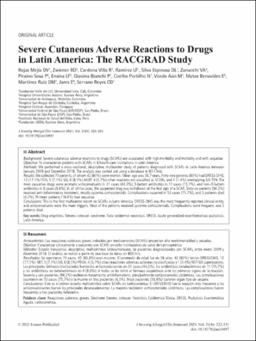| dc.description.abstract | Abstract
Background and objective: Severe cutaneous adverse reactions to drugs (SCARs) are associated with high morbidity and mortality and with sequelae. Objective: To characterize patients with SCARs in 8 health care institutions in Latin America.
Methods: We performed a cross-sectional, descriptive, multicenter study of patients diagnosed with SCARs in Latin America between January 2009 and December 2018. The analysis was carried out using a database in BD Clinic.
Results: We collected 70 patients, of whom 42 (60%) were women. Mean age was 38.7 years. Forty-two patients (60%) had DRESS-DIHS, 12 (17.1%) TEN, 5 (7.1%) SJS, 6 (8.5%) AGEP, 4 (5.7%) other reactions not classified as SCARs, and 1 (1.4%) overlapping SJS-TEN. The main causative drugs were aromatic anticonvulsants in 31 cases (44.3%), ß-lactam antibiotics in 11 cases (15.7%), and non-ß-lactam antibiotics in 6 cases (8.6%). In all of the cases, the suspected drug was withdrawn at the first sign of a SCAR. Sixty-six patients (94.2%) received anti-inflammatory treatment, mostly systemic corticosteroids. Complications occurred in 53 cases (75.7%), and 3 patients died (4.3%). Thirteen patients (18.6%) had sequelae.
Conclusions: This is the first multicenter report on SCARs in Latin America. DRESS-DIHS was the most frequently reported clinical entity, and anticonvulsants were the main triggers. Most of the patients received systemic corticosteroids. Complications were frequent, and 3 patients died.
Keywords: Acute generalized exanthematous pustulosis; DRESS; Drug eruptions; Latin America; Stevens-Johnson syndrome; Toxic epidermal necrolysis. | es |


